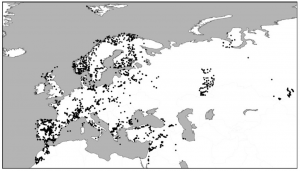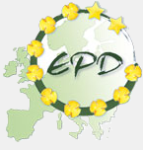The Eurasian Modern Pollen Database
The European Pollen Database (EPD) now includes modern pollen surface samples in their own database, the EMPD
The development of publicly-accessible databases of fossil pollen data in the last 20 years such as the European Pollen Database (EPD) (https://www.europeanpollendatabase.net/), have provided scientists with an unrivalled source of information to study past changes in terrestrial vegetation, land-cover and climate at large spatial scales over the Quaternary period. Interpreting this fossil pollen record however requires a clear understanding of the relationship between pollen as the proxy, and the environmental parameter (vegetation, land-cover, climate) that the pollen proxy represents. Understanding this relationship has largely been achieved through the use of modern pollen surface samples.
The EMPD is a standardised, fully documented and quality-controlled dataset of modern pollen samples which can be openly accessed, and to which scientists can also contribute and help maintain. After a major community based effort starting in 2011 we have now established a modern surface sample database within the EPD that contains almost 5000 samples. The European Modern Pollen Database (EMPD) is now available and free to download. The data includes both specifically collected modern surface samples from a variety of environments (soil, moss bolsters, lake and bog sediments etc), as well as modern ‘core top’ samples from fossil pollen cores.
Download the EMPD1
You can download all of the files below in one zip file EMPDv1, or individually:
- Reference publication Davis et al. (2013)
- Reference publication Davis et al. (2013) Erratum
- kml file (to view sites on Google Earth) v2b
- Metadata (site name, location etc) v2b
- Pollen count data: raw counts v3
- Climate data*
- Pollen count data: percentages*
- Pollen count data: percentages (table format)*
*Note these derived files are older and do not contain all of the sites that are now in the database
Important!
Please acknowledge the European Pollen Database in all publications. Use of the EMPD is conditional on compliance with EPD protocols.
The citation for the database is Davis et al. 2013. Please note the additional Erratum which provides some important corrections, particularly to the official author list.
EMPD stage 2: The second update to the EMPD is almost ready (Nov 2018)..
We have now collected and processed the data that was submitted as part of the second update to the EMPD. We received 2752 samples from over 60 research groups involving over 130 individual scientists. On behalf of the EPD we would like to say a huge thank you to all of you for your generosity in submitting your data to the database, and for the tremendous amount of hard work that went into collecting and analysing all of these samples. The data available now stretches all the way from Europe to Japan, and consequently we have decided to rename the database the Eurasian database to acknowledge this.
We expect the final update to reach over 3000 new samples once we have added some additional datasets, including new modern core top samples from the EPD.
You can view the new data using the web based EMPD viewer (click here), developed by Philipp Sommer.
Acknowledgements: as well as Manuel Chevalier and Philipp Sommer in Lausanne, the bulk of the file processing was undertaken by a team of volunteers during a 1 week work camp, including Vachel Carter, Walter Finsinger, Achille Mauri, Leanne Phelps, Marco Zanon. Many thanks to all of them for all the hard work that they put in.
We are now accepting data for EMPD stage 3. This data will be made available on the ‘Pending Data’ page in its raw unprocessed format.
If you have data from surface samples or core-top samples that you are willing to share, from as little as 1 to 1000, then please send them in (basil.davis@unil.ch). The EMPD only accepts raw count data, if you only have percentage data then we are still looking to make these available, but as a separate dataset. We would also like you to complete the metadata template file as best you can. Else, please at least provide the following information:
1) Author/Analyst and contact address & email
2) Any references/publications relating to the samples
3) Location (Latitude, Longitude, Altitude)
4) Type of sample (eg core top from lake/bog, moss polster, soil sample etc)
The following would also be useful:
5) Site description (type of site eg lake or bog etc, physical setting eg valley bottom, mountain top etc)
6) Size of site (eg hectare of lake or bog)
7) Surrounding vegetation
8) Collection method (eg trap, corer, assimilation of multiple-samples from area etc)
If you have copies of any relevant publications, then please include these.
Download the metadata template here. You should complete this as best you can and submit it together with your pollen data files, it would be a great help.
We welcome any data from Eurasia and North Africa, and including marine data from adjacent seas.
Frequently asked questions
What kind of samples (tauber trap, core top, moss polster etc) are you looking for? We are looking for any sample that represents a composite picture of vegetation cover over decadal timescales comparable with most fossil pollen samples, such as a core top, moss polster etc. The sample should represent a time window of around 10 or more years. For annual or sub-annual data from pollen traps, we suggest that you contact the Pollen Monitoring Program
Do you accept percentage data? The EPD only accepts raw count data. However, percentage data can still be useful. If you only have percentage data and do not have access to the raw counts for your data, we will still make it available but as a separate dataset.
How many samples do I need to submit? There is no minimum to the number of samples you can submit. Even just one sample can be very valuable, especially if it comes from a region that is currently under-represented in the database.
How modern is a modern surface sample? Most samples represent the last 50 years, but we also accept older samples up to 250 years ago (for instance a ‘core top’ sample) if the age is reasonably well know. An age estimate is provided for all samples where possible so that users can choose the age range of the samples that they want to work with.
What is the geographical area of the database? We accept samples from the whole of Eurasia and North Africa. We also accept marine pollen data. It is intended in future that all of the data in the EMPD will be made available through the Neotoma global palaeoecological database, and geographical restrictions are really only to help in the processing of the data. If in any doubt, please just ask.
How long will it take before my data is made public? EMPD2 is now completed, and we are now accepting data for EMPD3. It is not know when we will be ready to process the data for EMPD3, but in the meantime all of the raw data files submitted will be made available (unless requested) as soon as it is submitted via the pending data page.
Where can I find the current database? Please see follow the links above to download the EMPD1 database, associated publications, google earth files, as well as biome and climate data. EMPD2 will be ready for download in a provisional form in December 2018.
I don’t have any samples to share / I gave you all of my samples last time- can I still participate? Yes! absolutely. We are also looking for volunteers to help process the submitted data files, harmonise the taxonomy, find missing metadata and generally work on getting the data into shape for the database. We also need help with the analysis and writing of the co-authored paper.
Can you provide funding? Unfortunately the EPD is not in a position provide funding. Everyone working on the project is an unpaid volunteer. However, we could help for instance by writing a letter of support if you wanted to apply for funding elsewhere.
What is the European Pollen Database (EPD)? The EPD is an open public scientific database for late Quaternary fossil and modern pollen data, maintained largely through the voluntary efforts of the scientific community. You can find out more about the EPD on the official website here.
What is the Neotoma database? Neotoma is a new global multi-proxy palaeocological database. The EPD is in the process of being absorbed into Neotoma, along with all of the other regional pollen databases that used to form the Global Pollen Database. This process has begun, but will take some time.
Will the EMPD be available via the Neotoma database? Yes, the plan is that the database will become part of Neotoma but will still be extractable as a separate dataset. We will continue to provide separately additional useful derived datasets such as biomisations, percentages and modern climatology.
I also have fossil pollen data from a core, what should I do with it? Guidelines to help you submit any fossil pollen data to the EPD are available here. You can also contact the database manager Dr Michelle Leydet directly (michelle.leydet@imbe.fr). If you submit a new pollen site you also have the opportunity to write a short report about your site/data and have it published in the journal ‘Grana‘.

